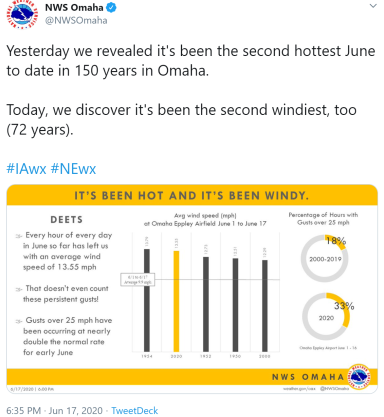| JUNE-AUGUST UPCOMING EVENTS: June 24: Weed Management Field Day-VIRTUAL July 8: Palmer Amaranth Mgmt Field Day-VIRTUAL Aug. 11: Soybean Management Field Days, Hildreth Aug. 12: Soybean Management Field Days, Elgin Aug. 13: Soybean Management Field Days, Shelby Aug. 14: Soybean Management Field Days, Arlington Aug. 20: Midwest Soil Health Clinic, ENREC Aug. 25: SCAL Field Day, Clay Center Aug. 26: Midwest Soybean Production Clinic, ENREC Aug. 27: Midwest Corn Production Clinic, ENREC June 3: Communicating with Farmers Under Stress webinar, 9 a.m., go.unl.edu/farmstress June 24: Weed Management Field Day, SCAL near Clay Center July 8: Palmer Amaranth Mgmt Field Day, near Carleton Aug. 11: Soybean Management Field Days, Hildreth Aug. 12: Soybean Management Field Days, Elgin Aug. 13: Soybean Management Field Days, Shelby Aug. 14: Soybean Management Field Days, Arlington Aug. 20: Midwest Soil Health Clinic, ENREC Aug. 25: SCAL Field Day, Clay Center Aug. 26: Midwest Soybean Production Clinic, ENREC Aug. 27: Midwest Corn Production Clinic, ENREC |
Crop Update: The National Weather Service in Omaha shared that it’s been the 2nd hottest June on record (150 years) and the 2nd windiest June (72 years). It’s truly taken its toll on people, plants, and animals. It’s also resulted in increased stress levels with much to be done (spraying, hilling/cultivating, fertigating, changing herbicide plans, etc.) as crops rapidly grow.

Since the Memorial Day rains, I’ve observed bacterial leaf streak (BLS) on corn in fields.

BLS has long, narrow, red/brown colored lesions that follow leaf veins. The lesions also have a yellow halo when backlit. Upon close examination, the lesion edges are wavy, which differentiate it from gray leaf spot. It started fairly minor, but some more susceptible hybrids are showing higher levels of lesions right now. There’s also been a number of whitish colored lesions on leaves from wind damage/sand blasting (if they weren’t due to herbicide situations). It’s from some of these wind damaged areas that BLS is also occurring. The bacterium causing BLS can infect directly through stomata; however, it can also infect through wounding. So the wind-driven rains and also high winds with sand blasting have also increased the incidence and severity of BLS in fields. Fungicides aren’t effective on it and it’s not known to result in yield loss.

Received a number of field calls/questions regarding herbicide application problems. Also recognize the challenge in figuring out a plan B, C, or D with some fields. Some practical things for those still needing to spray: know what traits are in what fields and double/triple check with whoever is spraying that the right product is going to the correct field. Double check the crop growth stage and the label as to what can be in the tank mix to avoid crop damage. Don’t go by plant height as there’s short beans that are flowering now and shorter corn in no-till and/or cover crop situations that is further along than one may realize. Proper tank/boom/nozzle cleanout is also always important to avoid crop damage to the next field being sprayed. And, spraying in high winds doesn’t help any of us.
For irrigation, UNL research shows we can wait till 35% depletion in the top 2 feet prior to tassel or top 3 feet once tasseling occurs. There’s a number of reasons why farmers have been irrigating: applying fertilizer, activating herbicide, small/replant crops with shallow roots, softening the topsoil for brace root establishment, and some may not be needing to water. There’s an article in this week’s CropWatch by Steve Melvin regarding irrigating considerations during the vegetative stages. We have a CropWatch poll to learn where people obtain their evapotranspiration (ET info.). Please help us by filling it out at: https://go.unl.edu/wxqv. There’s also ET and GDD info. available from CropWatch at: https://cropwatch.unl.edu/gdd-etdata and the NAWMN ETgage site (ET info. only) at: https://nawmn.unl.edu/ETdata/DataMap. The recent weather has helped with moving roots down. From digging plants and watching moisture sensors, many area fields from V7-10 have roots at least at 12” and below now.
Light Trap Reports: Light trap data can aid in scouting for various moth/butterfly pests. The closest light trap reports for the area are at UNL’s South Central Ag Lab near Clay Center and the Eastern NE Research and Extension Center near Mead. You can find all the reports online for the State at: https://entomology.unl.edu/fldcrops/lightrap.
Field Days: Weed Science (Clay Center) and Palmer Amaranth (Carleton) Field Days are cancelled for this year. Dr. Amit Jhala and his team are working on ways to present the data and information virtually. Nathan Mueller shared a self-guided tour is setup at the 2020 Jefferson County Winter Wheat Variety Trials in cooperation with Brian Maust (Variety Trial Technician) and Mark Knobel (hosting farmer). It’s located north of Fairbury on Hwy 15, then east 1 mile on 716th Rd, then 3/4 of a mile north on 569th Ave, east side of the road marked with a UNL sign. You can take a self-guided tour by grabbing a handout in the realtor box at the plots. It’s asked that you not walk/damage the wheat (i.e. pulling heads) and stay in the wide walking alleys. Please bring your own hand sanitizer so you can use it after touching the realtor box. Will keep you updated on additional information regarding these and other field days as details are released.

Also seeing low levels of woolly bear caterpillars in soybeans. This guy was moving with the wind/heat trying to get in lower canopy. Thresholds for soybean defoliation: 30% defoliation for anything defoliating soybean in vegetative stages and 20% with insects present in the soybean reproductive stages.




































